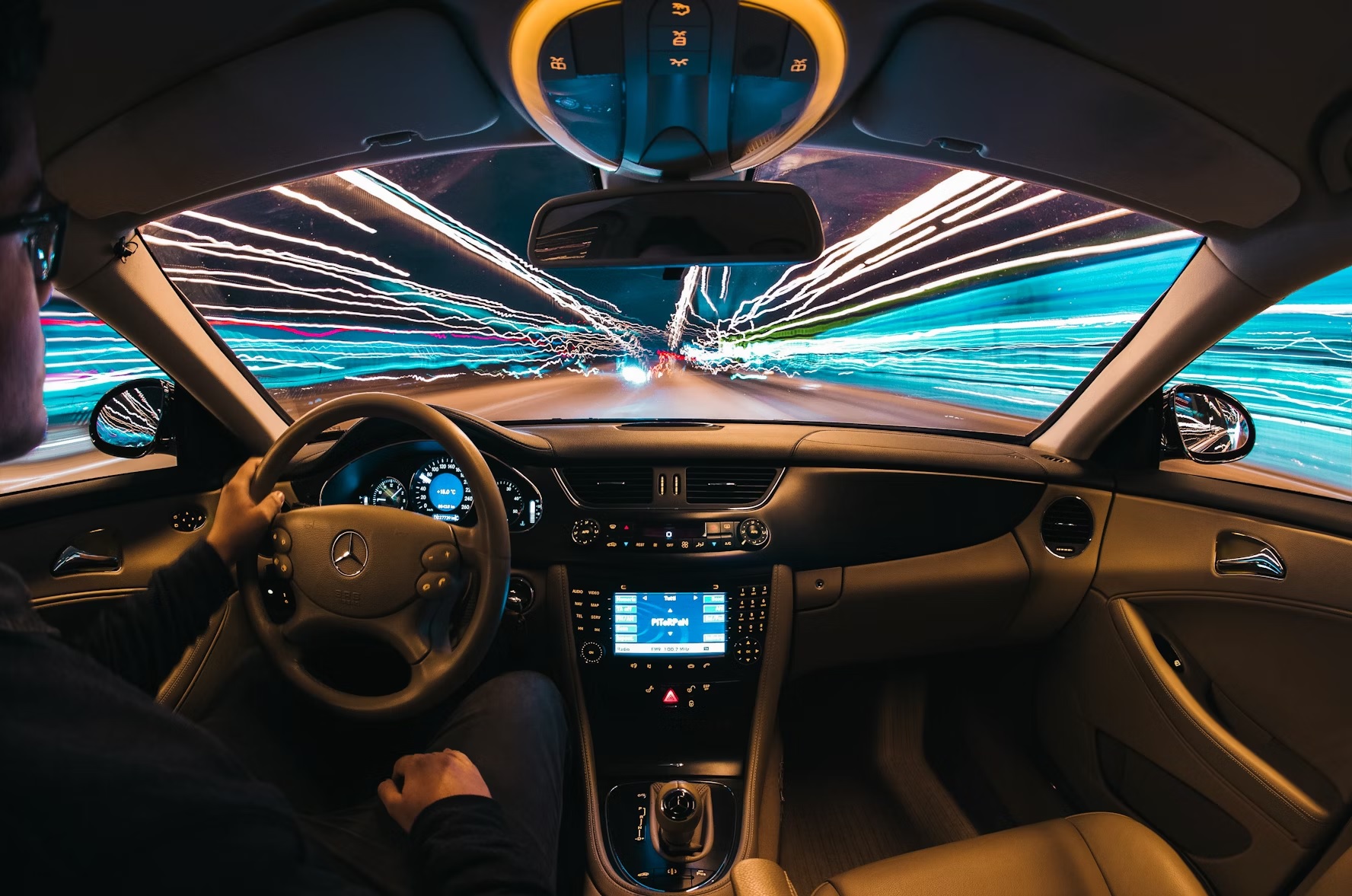AI, Take the Wheel.
 Tara H. Figg
Tara H. Figg
How close are we to mass-produced, affordable self-driving cars? And do we WANT that?
We’ve all been there: a long road trip, trying to concentrate on the road; kids are tired and yelling and/or crying and/or smearing sticky substances on each other. You - the parent - are exhausted. Your eyes are gritty, your head is pounding, you have that weird travel-sweat thing going on (which happens even if the AC is on), and you’d give anything just to close those gritty eyes.
In these instances, a self-driving car sounds like a delightful luxury. You can chat with the kids, watch a movie, SLEEP … all while your autonomous vehicle smoothly steers itself toward your destination.
We’re closer than you might realize. But how close - how affordable - how safe are AVs? And what if you actually love driving, and hate the idea of a robot pushing you out of the driver’s seat, so to speak?
From Sci-Fi to Reality
Self-driving cars were once the stuff of pure fiction. Now they’re a tangible reality - semi-autonomous vehicles now navigate roads around the world. It’s like watching a slice of “Total Recall” or “Minority Report” come to life. Earlier iterations of self-driving technology were focused on basic functionalities - adaptive cruise control, automated parking, etc.
But now we’re seeing more sophisticated implementations. Semi-autonomous cars now have advanced systems that can handle a variety of driving tasks, and it’s another step towards fully autonomous vehicles.
AVs in Real Life
Right now, self-driving technology includes features like Advanced Driver Assistance Systems (ADAS). These offer lane-keeping assistance, adaptive cruise control, and collision avoidance. If you have a newer vehicle - or have rented one, like I have - you’ve probably used these features, maybe even without knowing it.
Tesla has autopilot systems that allow cars to steer, accelerate, and brake automatically within certain conditions. Waymo - formerly known as the Google Self-Driving Car Project - is now offering fully autonomous ridesharing services in some urban areas.
General Motors' Cruise and Uber's Advanced Technologies Group, among others, are also exploring the possibilities of AVs. They’ve been testing out self-driving tech, working to refine these systems to promote safety and reliability.
How Does it Work?
So how does it all work? Artificial Intelligence (AI) and machine learning (ML) are key. If you’ve been living under a rock, AI refers to the capability of machines to perform tasks that typically require human intelligence (recognizing objects, making decisions, etc.). ML is a subset of AI; it involves training algorithms on large datasets to learn patterns and make predictions.
In the world of AVs, that means analyzing data from sensors to understand and react to the driving environment. AI systems can continuously learn and improve from this data to make more and more accurate, reliable decisions.
Self-driving cars rely on other technology, like lidar, radar, and cameras. Lidar (Light Detection and Ranging) uses laser pulses to create detailed 3D maps of the car's surroundings. This helps the car detect obstacles and measure distances accurately.
Radar systems use radio waves to provide information about the speed and position of objects. Camera, of course, capture visual data so that the car can recognize pedestrians, traffic signals, and other vehicles.
AI processes all this sensor data in real-time - obviously, or the AV would crash into the closest car. The sensor data allows the AV to “see” the road and make instantaneous decisions - like if a person steps into the road, the AV can “see” them and hit the brakes right away. Safe AVs need seamless integration of AI with sensory technology for safety and efficiency.
Stuck in Traffic
As with all things, AI isn’t a replacement for humanity. There will probably always be certain driving conditions that AI will struggle to handle. For one thing, city streets are vastly different from country highways - which in turn are different from multi-lane interstates. Urban environments are rife with pedestrians, cyclists, traffic signals, unpredictable driver behavior, gridlock traffic - it can be hard for AI to anticipate and react to every potential scenario.
Highways are more straightforward; but can involve a huge variety of possibilities, depending on where you’re driving. Think of the farmland of Iowa; you can be cruising along at 55 miles per hour, when suddenly you’re stuck behind a slow-moving tractor or even a herd of escaped cows. Or consider northern Wisconsin, where you’re competing for road space with log trucks and a plethora of deer.
And then interstates, which involve high-speed lane changes and merging traffic, as well as navigating exits - there are infinite scenarios that may arise when you take to the roads, streets, highways, or interstates of our world. It’s no easy task to develop AI capable of handling all these complexities.
Roads Go Ever Ever On
As Bilbo so wisely observed:
The Road goes ever on and on,
Down from the door where it began.
Now far ahead the Road has gone,
And I must follow, if I can. (1)
Our roads have evolved; so have our vehicles, far ahead, as our beloved hobbit noted. And we must follow - and we can, but it’s not going to be an easy journey. Safety concerns are valid; we will have to ensure the reliability of self-driving cars so that they can handle the unexpected. AI systems need to be able to make split-second decisions in emergencies. They have to account for erratic driving from other drivers or sudden obstacles.
And the systems have to be virtually flawless in order to gain public trust and meet safety standards. Other barriers will include regulatory and legal challenges; laws and regulations governing AVs might vary widely between regions and there’s already a lack of consistent global standards.
Ethics are also important - decision making in unavoidable collision scenarios will be called into question. It will be essential to establish a thorough legal framework and set of ethical guidelines for the safe integration of AVs into society.
In the end, I think AVs are going to become more commonplace; but they won’t replace human drivers. After all, there are so many of us that love the feel of the steering wheel in our hands, the power and control it gives us, the wind in our hair, and the ability to steer our own destiny. Like all AI tools, AVs will be an option; not a replacement.
1 - Tolkien, J.R.R. The Hobbit. HarperCollins, 2012.
Subscribe to my newsletter
Read articles from Tara H. Figg directly inside your inbox. Subscribe to the newsletter, and don't miss out.
Written by

Tara H. Figg
Tara H. Figg
I'm a tech writer, copywriter, novelist, blogger - I've written for ABC, NBC, and CBS affiliates, NASDAQ, Forbes, MSN, Business Insider, Yahoo Finance, Associated Press, Harvard Business Review, Bloomberg, and more. I have written quite a bit on cybersecurity and information security, AI and its subsets (GenAI, ML, LLM, deep learning, etc.), and cloud migration.




